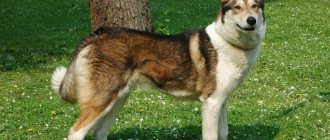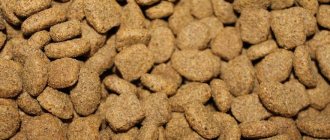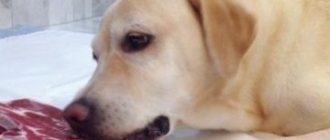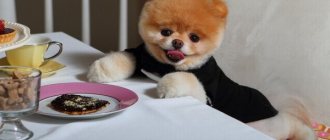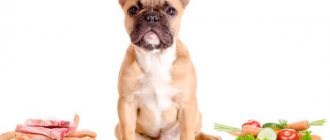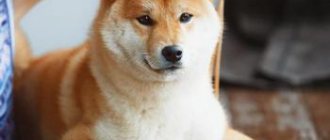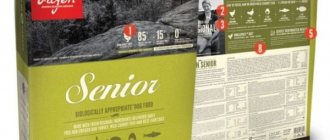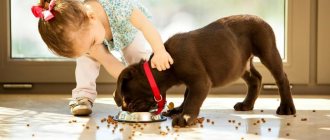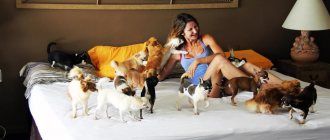Laika is the dog closest to wolves, the distant ancestors of all dogs in the world. This breed is one of the best among hunting ones. It is very important to note that huskies eat less than other dogs and are not at all prone to excessive weight gain.
What you feed your husky plays a big role in its well-being and ability to work. And proper feeding of husky puppies is even more important, because a young growing body needs healthy and nutritious food. Only plant foods are not suitable for dogs, just like food from the human table.
Nutritional features of huskies
A special feature of the breed is the ability to eat a small amount of food, digest heavy food and go without food for quite a long time.
At the same time, huskies are omnivorous and very sociable dogs. Therefore, they are ready to gobble up everything that can be offered to them. Consequently, representatives of the breed need very strict control over their diet and portion size.
It is necessary to start learning to eat regularly and properly from a very young age. Only in this case will the husky please you with its health and excellent working qualities.
There has been debate for a long time about what type of food is more suitable for man's four-legged friends: industrial food or natural food. Each owner makes his own choice of how to feed his pet.
Hunting training
It is worth noting that not every husky puppy can be taught hunting skills. In order to determine whether your dog is suitable as a cop, you need to observe its habits and disposition, especially in relation to fresh tracks of other animals. If the dog is indifferent to them, then he will not become a hunter. However, if your four-legged friend is constantly sniffing at them, it would be advisable to conduct several training sessions to teach hunting wisdom.
The optimal age for becoming familiar with the character and disposition of an animal is 10 months. At this time, you can go into the forest with your dog and see what object he chooses for hunting. It is desirable that the vegetation in this forest be relatively low.
The training process involves several tricks, as a result of which the animal will learn to be an obedient companion and an intelligent watchman. First, you will need to accustom your pet to the forest in order to develop the hunter's instinct in him. Don't spare your personal time and let the puppy run around the forest to his heart's content. He must sniff and examine all the places that interest him. As a result of various canine techniques, you can teach a dog:
- detain large prey in one place;
- distract the attention of predators from the owner;
- to attack the trail of this or that prey;
- scare wild birds by raising them on the wing.
As a rule, the husky quickly gets used to hunting certain game. It will not be difficult for such a dog to catch a hare, squirrel or marten. Don't forget to praise your dog for any success he achieves. It is necessary to make it clear to the cop that her actions are correct. Only in this case will you be able to raise a faithful assistant and a good hunter.
We hope our article helped you better understand what to feed your husky puppy. Remember that the diet should consist only of natural products, and not prepared foods. Also, you should not overfeed a young dog if you want to raise him to be a hunting assistant and not a couch potato.
Feeding dry food
The main argument of opponents of this type of nutrition is problems with the kidneys and liver of huskies after prolonged use of dry food. Indeed, industrial feed can have a similar effect if the owner chooses cheap options with a high content of salt and chemicals (economy class feed).
How to choose the right quality dry food?
To feed your husky, you need to choose super premium food (Duck`s Farm, Acana, Eucanuba, Now, Monge, Pro Plan) and holistic food (Grandorf, Pronature, Now, Go!).
The prepared food must include:
- Meat (poultry, beef) and offal;
- A small amount of legumes;
- Vegetables and berries;
- Vitamin supplements and microelements.
The cost of these brands is high, therefore, on the advice of veterinarians, you need to choose ones that do not contain corn and other cereals, dyes, imitators and flavor enhancers.
Despite the fact that super premium and holistic food are high-quality products, your dog may experience negative reactions when consuming them. To understand when you need to change food, you need to monitor your pet's health. A signal for this could be:
- the dog refuses to eat on its own;
- manifestations of allergies appeared: hair falls out, the dog itches, crusts and redness on the ears;
- frequent gastrointestinal disorders.
All these manifestations should alert you and force you to contact a veterinarian.
We also performed a detailed analysis of the following feeds: Proplan, Monje, Dog Chow, Brit.
Breed standard
The West Siberian Laika, according to the current standard today, is of medium height, strong, and balanced in structure. When assessing, what will be important is not the exact weight and height data, but the correct proportions of the animal’s body.
West Siberian Laika - soft gold hunter
- Height 58–65 centimeters for males, 52–60 for females.
- Wedge-shaped head. Somewhat elongated, not too wide. The forehead is almost straight, with a pronounced bend at the junction of the muzzle. The bridge of the nose is straight. Well defined occiput and crown. The muzzle is not narrow, but not wide either. Has a slight expansion in the area where the fangs are located. Cheekbones and cheeks are lifted. The eye sockets are practically not expressed (the color with the so-called “eyebrows” creates the opposite sensation). The lips are well adjacent to the muzzle, pigmentation along the lower line.
- The nose is pigmented. Wide and agile.
- The teeth are completely complete. The bite is correct. The fangs are quite large.
- The eyes are almond-shaped, somewhat slanted. The iris is colored brown; according to the standard, darker colors are preferable. The eyelids are completely pigmented.
- The ears are shaped like pointed triangles of regular shape. Constantly raised and mobile.
- The body is rectangular, elongated. The square body format does not correspond to the standard. Strong back. For bitches, a straight back line is acceptable. The withers are pronounced. The neck is not too long, curved, oval. The raised croup flows smoothly into the hips. The chest is muscular and moderately wide. The transition from the groin line to the sternum is not sharp.
- The limbs are powerful, smooth, tightly assembled. The joints are pronounced. The height of the forelimbs is approximately half the height of the animal. The angles of the paw joints are harmonious.
- The tail is in the shape of a ring or sickle (this shape is acceptable only if the tip is thrown over the back).
The fur on the body is hard and very thick.
The standard allows several color options:
- gray (“wolf”);
- brown (red);
- white with a brown or black nose.
It should be noted that since the breed was bred from several types of huskies, individuals within the breed may differ from each other. The appearance of each animal will be more consistent with the type from which its ancestors were.
The West Siberian Laika, according to the current standard today, is of medium height
The West Siberian Laika dog is a medium-sized breed, although some experts classify it as large. The dog's physique is proportional, he is well built. It is believed that it was selected for many years. Ancient representatives of the breed were much larger than modern ones.
However, their massiveness deprived them of such an important skill necessary for hunting as agility. According to the standard, the weight of a normal representative of the breed should not exceed 20-23 kg
Some young females weigh 15-15 kg and this is not a deviation. The height of an average-sized individual is 58-60 cm.
It must be said that the above parameters are not so important for the judicial analysis of the West Siberian Laika. Experts evaluate this animal, first of all, by the harmony of its body parts, that is, they analyze how well it is built.
The wedge-shaped head is slightly elongated. The transition to the muzzle is smooth. The dog's jaw is tightened, his lips are dry, his teeth are snow-white and strong. According to the standard, the bite of a purebred husky should be scissor-shaped.
His ears are triangular, have pointed corners, and erect. The nose is large, pigmented, often black. The look of the West Siberian Laika in the photo is expressive and interested. Her almond-shaped eyes are set shallowly. Their shade is black or dark brown.
All dogs bred in Siberia have a dense undercoat. It performs an important protective function of insulation. The animal is not afraid of frost and blizzard. The dog's fur grows straight, vertically in relation to his body, this gives the impression that he has a fluffy fur coat.
The dog's appearance is really bright and elegant. There are a lot of colors. Popular options:
- Pure white.
- Sandy brown.
- Pure brown.
- Ginger.
- Red-gray.
- Black and white.
Natural diet
Be sure to feed a varied and balanced diet.
Must-have products
| Product | What types can | How to cook |
| Meat | Turkey, beef, horse meat, rabbit, wild game meat | Can be given raw (after freezing), boiled or dried. |
| Fish | River and sea. Only without small bones! | Boil, thoroughly remove bones and other sharp parts. It is acceptable to dry or dry it and use it as a reward for hunting. |
| Vegetables and fruits | Any seasonal vegetables, apples, pears, berries in season | Fresh, boiled, and can be dried. |
| Cereals | Rice, buckwheat, pearl barley | Cook porridge |
| Calcium-rich foods | Dried fruits, nuts, sour milk | Cut or crush the kernels and add to food |
| Eggs | Chicken or quail | Raw |
| Bones and tendons | Beef | Raw |
| Oil | Olive or other vegetable | A spoonful of butter is added to a dog's food if there is a lack of fat. |
It is better to prepare food for a maximum of two days; it must be stored in the refrigerator. The dog is served warm.
This is how they feed huskies in the taiga!
And here is an example of a diet of veins and buckwheat porridge.
Origin story
The breed was bred for hunting, and its character and physical characteristics only confirm this purpose.
In the 20s of the last century, the USSR began planned breeding of Siberian huskies and bringing the breed to a single standard. At that time, about 10 varieties were identified, which received the names of the nationalities that bred them (Karelian, Ostyak, Zyryan, Khanty, Mansi and others).
The origin of the dog begins with different types of huskies from the Urals and Siberia. When crossing, they tried to preserve the qualities of the Khanty and Mansi Laikas. Thanks to the harsh climate of the taiga, only hardy individuals with a strong character survived. They benefited people. Weaker dogs were exterminated because funds were needed to maintain them. As a result of this selection, the breed is valued all over the world.
The second stage of history began in the 20s of the 20th century. At this time, work began to bring the breed to a general standard. Dogs were especially popular because they helped in the extraction of furs; during the war they were used as demolitions and cargo carriers. The final breed standard was approved in 1952. The dogs were actively bred, and in 1980 they were recognized by the International Canine Association.
What not to feed
The following types of products are excluded from the natural diet:
- Pork;
- Corn;
- Sweets and flour;
- Smoked, salted and food with a lot of spices.
Constantly monitor your pet's health. Under no circumstances should you feed from your table. To avoid allergic reactions, you should not change your dog’s diet or introduce a new type of food in large quantities at once.
If you experience a negative reaction to food, you must stop feeding this product and contact a clinic.
Not recommended products
Buy dry food of the “Premium” class, this will have a beneficial effect on the health of the animal, unlike budget food. It is better not to abuse such food; give dry food occasionally. It is strictly not recommended to switch your animal to a diet consisting only of dry food.
It is better to exclude sausages, sausages, pates from the diet completely, but you can sometimes allow the dog as a treat or reward for good behavior.
It is not recommended to give adult dogs dairy and fermented milk products, although they must be present in the diet of a small puppy.
What to feed a husky puppy
If you choose ready-made food to feed your baby husky, you can help the puppy by soaking the dry granules in boiled water. It is worth remembering that you cannot leave wet granules for a long time. This is especially true during the warm season. After your baby has eaten, remove the bowl. This will discipline him and prevent his food from going sour.
| Puppy age (in months) | Number of feedings per day | Diet and serving size |
| Up to 1 month |
|
|
| From 1 month to six months | The number of feedings at two months of age decreases, reaching 4. |
|
| From 6 months to a year | By one year - 2 times a day |
|
When determining the serving size, you must be guided by the puppy's activity, health and weight.
If a small husky does not gain weight, at the age of 1.5 months it is necessary to carry out antiparasitic treatment with special drugs.
Do not give your baby fatty meats. The value of the diet is in protein, not fat.
Here is a short video about how the owner feeds the puppies with milk, it is not very informative, but look how cute they are!
Correspondence between the puppy's weight and height by month
To monitor development, it is necessary to know height and weight indicators in specific months. If a pet at 1 month weighs about 2.2 kg with a height of 27 cm, then at two months it will be twice as heavy and 8 cm taller. For a three-month-old, a weight of 8.5-9 kg is sufficient, while the height at the withers should be at least 42 cm. A 4-month-old baby will be 5 cm taller and 2.5 kg heavier.
For a 5-month-old, the normal weight is 15 kg at 52 cm. But a pet that has matured by a month will weigh 1 kg more at 54 cm.
What to feed an adult husky
An adult dog should receive food twice a day. The diet finally develops when the dog reaches the age of 2 years. The number of feedings and portions should be increased when the load on the dog increases: participation in hunting, competitions.
In the morning the dog should be fed after a walk (7 - 8 a.m.), in the evening it is better to do this at 10 p.m. The third feeding is carried out at approximately 15 hours, if such a need arises.
The serving size is calculated based on the table of the manufacturer of the ready-made diet, or independently, based on the rule: the daily serving is about 3% of the dog’s weight.
Be sure to change the feeding regimen depending on the time of year. In summer, appetite decreases due to the heat, and winter vitamin deficiency is compensated for. During this period, increase the amount of water and introduce more fruits and berries into the diet.
In winter, much more energy will be required, so the proportion of fiber is reduced and the amount of protein is increased, and vitamin supplements are additionally selected.
Here is a very useful and detailed recipe for porridge for huskies made from trimmings.
Boar
Laikas are dogs that are often used when hunting large animals. When hunting wild boar, huskies are considered the most preferred breed because they have viciousness, passion and fearlessness. West Siberian huskies, which have an exceptional dislike for pigs, are especially effective in hunting wild boar. But Karelian-Finnish and Russian-European huskies are more careful, which must be taken into account when going hunting.
It is recommended to start training huskies with wild boars at the age of eight months. It is recommended that from the age of 3 months you give him a piece of boar skin for playing. Games need to be structured in such a way that everything works out for him, the puppy should not be beaten, his aggressiveness should not be suppressed, and older dogs should not be allowed to offend him.
At 8 months of age, he must be brought to a hunted boar, allowed to sniff thoroughly, lick the blood, and be sure, like other dogs, to be given a piece of meat during cutting. At this stage you will be able to evaluate the dog's working qualities. If she immediately attacks the animal and begins to tear its bristles, then it will work well on a live boar. If the puppy is afraid of the wild boar, take him to the animal yourself and let him pet him. At this moment, her eyes should light up with anger and excitement. If the puppy remains fearful, it is better to immediately reorient it from the wild boar to other animals.
They go to the area for training on their own with a young dog to familiarize the husky with the tracks of a wild boar. From the age of 10 months, he can be taken on hunts, in which experienced huskies participate, who will teach the dog everything using a clear example.
At the baiting station, training begins at 10 months. The first lessons should not exceed a quarter of an hour, and there should be no cleavers in the enclosure. For the first time, it is enough for the dog to bark at the boar from a distance of five meters until it rushes at it. The dog must then chase him. If this does not happen, scare off the animal yourself and start the chase.
Vitamins and mineral supplements
If the diet is based on high-quality ready-made food, such vitamin support is not necessary.
In other cases, especially during the off-season, you need to select ready-made vitamin and mineral complexes:
- To improve coat quality – Anivital CaniDerm,
- Vitamins for puppies - Wolmar Bio Booster Ca, 8 in 1 Exel, Unitabs junior complex;
- Calcium preparations - 8 in 1 Excel;
- For nursing bitches – Polivit Polidex, Pro Bio Booster;
- Universal additive – fish meal Good fish meal.
Capercaillie
Experienced hunters note that training a husky to hunt a capercaillie is no fundamentally different from trying to teach it to hunt other upland game - hazel grouse, black grouse.
Training should begin with the beginning of the summer-autumn season, when the bird has not yet matured and is kept mainly by broods. Most often, having risen to the wing, they cannot fly far, noisily perching on nearby trees. Kluha, with her loud cackling, can only provoke the dog.
Remember that wood grouse at this time are located in old clearings, surrounded by forest on all sides, as well as along forest streams, in remote places where people rarely visit, but there is a lot of gonobobel, blueberries and lingonberries. You need to arrive early to hunt the game, no later than six o’clock in the morning, when the dew has not yet dried, the husky can easily catch the trace of the bird. At this time, the fat deposits should still be clearly visible on the trampled grass; the dog will become interested in them and begin to try to figure them out.
Approaching the bird, the young husky slows down, begins to bend down and sneak up, and then makes a sharp jump. The bird flies up, lifting the entire brood with it. Having flown a short distance, wood grouse sit down in the trees. After the birds take off, the husky begins to chase the wood grouse closest to it. Running up to the tree on which he will settle down, she takes a comfortable position and wags her tail or bursts out into a ringing and loud bark.
At this moment, the hunter is recommended to approach the head of the barking dog as quietly as possible, so that the bird, interested in the barking, looks at it and does not notice you. From a distance of about 25 meters you need to fire a shot while barking. A successful hit is the key to successful training and subsequent hunting with this dog. Cut off the paw from the first capercaillie caught using a husky and give it as a treat, one finger at a time in three doses.
Sample menu for the week
| Day of the week | Menu |
| Monday | 1. Morning. Lean meat in the amount of 500 g (turkey or beef). Pour a quarter glass of bio-yogurt, add fish oil, an alternative to which is flaxseed oil. The quantity should be 0.5 tsp. Add 100 g of vitamin E. 2. Evening. Meat or by-products in the amount of 200 g. Add vegetables (150 g) to it. Pour in organic yoghurt along with a teaspoon of apple cider vinegar and two teaspoons of olive oil. Give your dog vitamin C and vitamin B1 (1 tablet for each vitamin). |
| Tuesday (fish day) | 1. Morning. 500 g lean beef or turkey. Pour over a quarter of bio-yogurt, add to 0.5 tsp. fish oil, can be replaced with flaxseed oil or salmon oil capsules. Give vitamin E 100 mg after meals. 2. Evening. 270 g sea fish or minced fish, 150 g vegetables, 1 yolk, 1 tsp. apple cider vinegar, bio-yogurt, 2 tsp. olive oil. Give vitamins C (1 tablet) and vitamin B (1 tablet) |
| Wednesday | 1. Morning. Lean meat in the amount of 500 g (turkey or beef). Pour a quarter glass of bio-yogurt, add fish oil, an alternative to which is flaxseed oil. The quantity should be 0.5 tsp. Add 100 g of vitamin E. 2. Evening. Meat or by-products in the amount of 200 g. Add vegetables (150 g) to it. Pour in organic yoghurt along with a teaspoon of apple cider vinegar and two teaspoons of olive oil. Give your dog vitamin C and vitamin B1 (1 tablet for each vitamin). |
| Thursday | 1. Morning. Lean meat in the amount of 500 g (turkey or beef). Pour a quarter glass of bio-yogurt, add fish oil, an alternative to which is flaxseed oil. The quantity should be 0.5 tsp. Add 100 g of vitamin E. 2. Evening. Meat or by-products in the amount of 200 g. Add vegetables (150 g) to it. Pour in organic yoghurt along with a teaspoon of apple cider vinegar and two teaspoons of olive oil. Give your dog vitamin C and vitamin B1 (1 tablet for each vitamin). |
| Friday (Curd Day) | 1. Morning. 500 g lean beef or turkey. Pour over a quarter of bio-yogurt, add to 0.5 tsp. fish oil, can be replaced with flaxseed oil or salmon oil capsules. Give vitamin E 100 mg after meals. 2. 300 g low-fat cottage cheese, 150 g vegetables, 1 yolk, 1 tsp. apple cider vinegar, bio-yogurt, 2 tsp. olive oil. Give vitamins C (1 tablet) and vitamin B (1 tablet) |
| Saturday | 1. Morning. Lean meat in the amount of 500 g (turkey or beef). Pour a quarter glass of bio-yogurt, add fish oil, an alternative to which is flaxseed oil. The quantity should be 0.5 tsp. Add 100 g of vitamin E. 2. Evening. Meat or by-products in the amount of 200 g. Add vegetables (150 g) to it. Pour in organic yoghurt along with a teaspoon of apple cider vinegar and two teaspoons of olive oil. Give your dog vitamin C and vitamin B1 (1 tablet for each vitamin). |
| Sunday (meat day) | 1. In the morning. 350 g of meat (beef or turkey), pour over a quarter cup of bio-yogurt, 0.5 tsp. fish oil or flaxseed oil, 100 mg vitamin E. 2. Evening. 200 g meat, 150 g porridge, 1 yolk, 1 tsp. apple cider vinegar, bio-yogurt, 2 tsp. olive oil. Vitamin C – 1 tablet, vitamin B – 500 g. |
